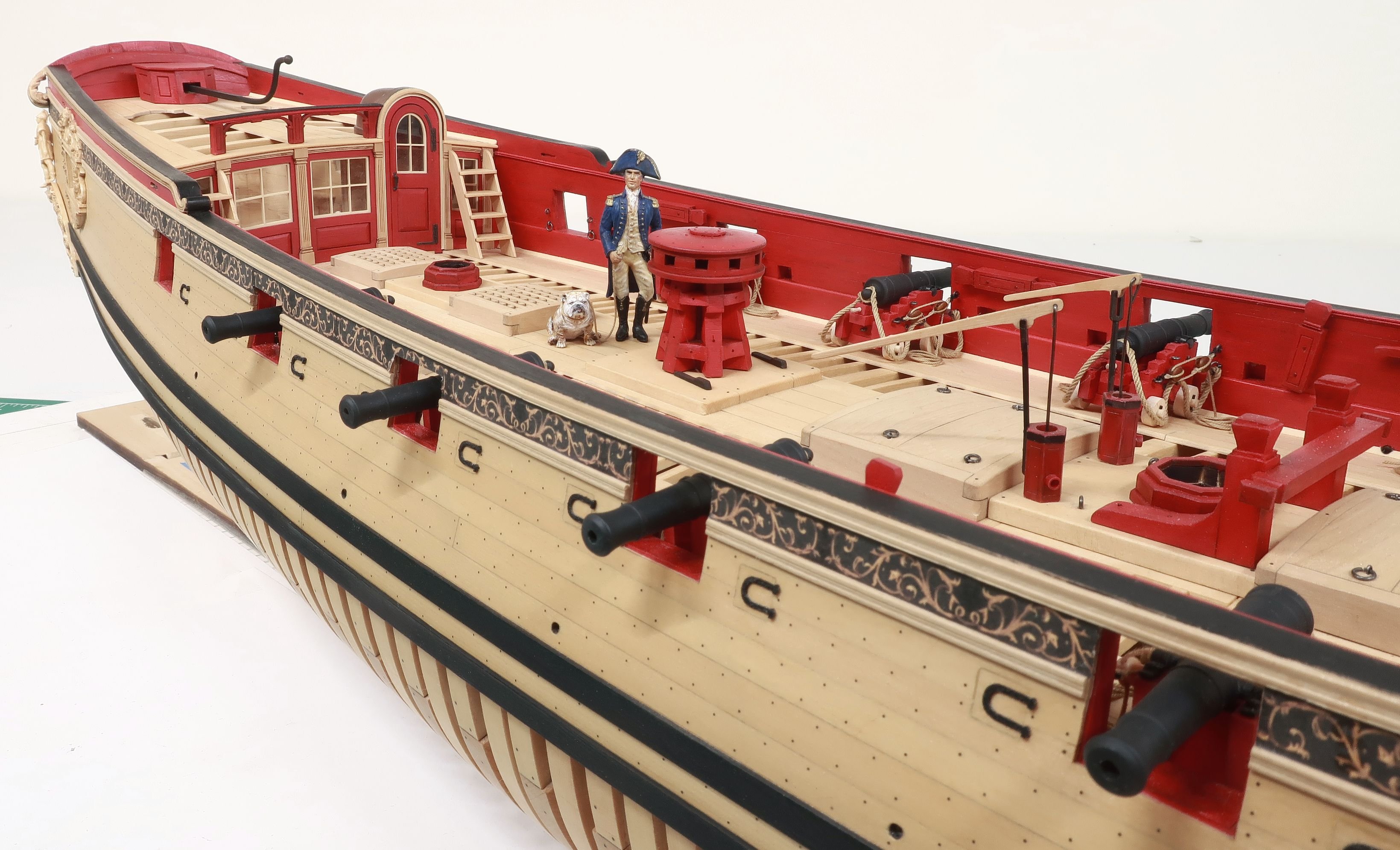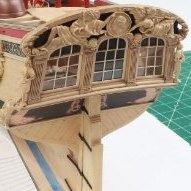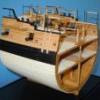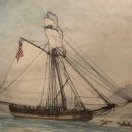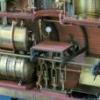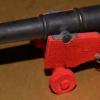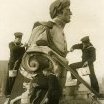MORE HANDBOOKS ARE ON THEIR WAY! We will let you know when they get here.
×
-
Posts
9,532 -
Joined
-
Last visited
Reputation Activity
-
 Chuck got a reaction from FrankWouts in HMS Winchelsea - FINISHED - 1764 - by Chuck (1/4" scale)
Chuck got a reaction from FrankWouts in HMS Winchelsea - FINISHED - 1764 - by Chuck (1/4" scale)
I have completed all of the partners and coamings......I can almost start planking the deck now. I forgot one last detail which I will show you guys soon. But here are some pics.
The foremast partners are made from laser cut parts and then I added the bolts. I used 15 pound filament for those. Use a #75 drill bit for the holes.
You can also see the base plate for the stove. You have a few options with this. I have laser cut a nice base for you. At this time the base was most likely just a large iron plate....but in some cases they used flagstone or slate. If you want to depict the iron plate....just flip it over and paint it matte black. But if you want to show some slate or flagstones, I have laser etched the other side with a stone tile pattern.
Simply paint it matte black first but keep the coaming natural. Then use some weathering powders on the tiles to make them only slightly lighter. Leave the etched grout lines (which are deeper) dark black. But use some grays and rust colors to make a subtle stone base. Dont over do it!!!
The main mast partners were done the same as the fore mast partners. None of these are glued in position yet but I will be doing so soon!!!
Any comments or questions!!!!!!!
-
 Chuck got a reaction from FrankWouts in HMS Winchelsea - FINISHED - 1764 - by Chuck (1/4" scale)
Chuck got a reaction from FrankWouts in HMS Winchelsea - FINISHED - 1764 - by Chuck (1/4" scale)
Back to the Winnie....
To make the gratings for the gun deck you will need 3 packages of my cambered grating mini kits. I will not be including these in the package for chapter 4 because I sell them in either cedar (less expensive) or boxwood. Both would work and you guys can choose. You will also need the grating jig. One jig should last you the entire project.
To start, figure out how many cambered laser cut grating strips you will need to fit the space in your coaming. Only build what you need. For example this grating below on left side needed just seven grating strips in the jig. My coaming were designed so each grating will fit perfectly when finished. So dont use more than the space needs.
Then use the supplied strips and press them into the notches carefully. You will notice they will probably be too tight at first. This is by design. You need to run some sandpaper down the strip until it becomes a nice press-fit into the notches. Once again only use the number of strips you need. In this case 13 strips pressed firmly in position...
At this stage you should look it over to make sure no grating strips went crooked while you were fitting the batten strips. If they did your holes wont be equal in shape and size. Fix those now using a toothpick if they lean over. Its easy to do.
Then paint on some watered down tite-bond. Get it in all the nooks and crannies. Not too thick. If the holes start clogging....add more water.
Wait about 2 minutes but not so long that the glue will dry. You want to carefully pry the grating free of the jig before it dries and is glued to the jig!!!
Then clean up the jig for the next grating. But you are not done yet. Brush more glue on the bottom underside of the grating. Set it aside to dry fully.
Now you are probably saying.... how in world will these ugly dirty gratings look good. Right now they look awful.
Snip off the excess from the perimeter and file the sides smooth. Check the fit in the coaming. Then start sanding the top surface. In the center photo below you can see I have sanding that grating only on one side. The finished grating can be seen coming to light.
The one on the right is completed. These are cedar gratings by the way. Now should you sand the bottom too? You dont have to.....BUT, I am sure you have seen those contemporary models and have seen how thin they are. I wouldnt recommend going too thin. But it does change the way the grating looks in the coaming.
And here are the finished coamings with the gratings in position.
ANY QUESTIONS????
-
 Chuck got a reaction from FrankWouts in HMS Winchelsea - FINISHED - 1764 - by Chuck (1/4" scale)
Chuck got a reaction from FrankWouts in HMS Winchelsea - FINISHED - 1764 - by Chuck (1/4" scale)
Next up it was time to add the second layer of spirketting (the lower two strakes) and the 7/32" wide plank above the ports. I used planks that were the same width but just 1/32" thick. You can even sand them thinner if you like. I also added the aft shell for fixed block. See it forward of the panelling? This should be added at this stage so you can plank the second layer around it.
Note how I also added one more 1/32" second layer strake above that 7/32" wide strip. The top edge follows along the bottom of the notches in the deck clamp. I use various width strips because you will need to taper it. It is not a consistent width. Just make sure the top edge is flush with the bottom of the notches in the deck clamp. MOST important....look at the forward end of this additional trip. Notice where it starts in relationship to the first notch in the deck clamp. This is important because it will aid you later when we build the platforms for the gangways.
Here is a view of the bow area. Same things apply. Notice where the aft end of the plank ends in this instance. Once again it is even with that first notch.
Sand everything smooth and prep the bulwarks for painting. Then paint it red. But dont paint the fancy panels aft. Here is what my model looks like at this stage. I still have to complete the port side....havent started planking that yet.
-
 Chuck got a reaction from FrankWouts in HMS Winchelsea - FINISHED - 1764 - by Chuck (1/4" scale)
Chuck got a reaction from FrankWouts in HMS Winchelsea - FINISHED - 1764 - by Chuck (1/4" scale)
That is what the thicker layer of bulwark strakes that are between the gun ports and the deck. They are usually about an inch thicker so when you see a model they stand proud of the strakes above Them .
In the contemporary example below they are painted red. But the strakes above them are not. Look at the planking in the waist.
DSC01571 -
 Chuck got a reaction from FrankWouts in HMS Winchelsea - FINISHED - 1764 - by Chuck (1/4" scale)
Chuck got a reaction from FrankWouts in HMS Winchelsea - FINISHED - 1764 - by Chuck (1/4" scale)
No not at all....we wont be building each paneled section. They are laser etched. But you could go that route if you are feeling ambitious. Let me show you what I have been up to. The bulwarks have been planked inboard with their first layer of planks. The first photo below shows the different widths I used. This might be slightly different on your model but you get the idea.
The bottom two strakes will have the top edge flush with the bottom of the ports. The three strakes above that between each port were divided up so the top of those was flush with the top of the gun ports.
On top of that goes a strip of 7/32" x 3/64" cedar. This takes you to the shear along the waist. I have NOT simulated the seams with pencil because they will all be painted red. The inboard layer of the fixed blocks were added too and the planking carefully cut around them. BUT....wait until after you plank the first layer of the inboard bulwarks to put the aft-most fixed block shell in position. It falls on the deck clamp which is thicker and this particular fixed block sheel should be glued on TOP of the first layer of Bulwark planking.
The deck clamps are laser cut for you. The quarter deck clamp is in two lengths. You need to add the forward section first. Line up the front of it with the hance piece. This is important!!! The notches laser cut in the deck clamp are for the quarter deck beams. We want to make sure they are lined up properly on both sides. If done properly your deck beams wont be crooked!!! Dont sand the laser char off the seam between the two pieces. This will screw up the placement of the deck beams. Just butt them together.
Once the forward section is glued in place....glue in the aft section. Below.
This was left a bit longer on the aft side so you can tweak it to fit your model. Another really important note.
You will notice that the bottom of the last notch in the deck clamp is even with the top of the stern windows. This is crucial. If your deck beams are too high it would be trouble. A little lower wouldnt hurt though to be safe. So please please make sure that this is correct. You will need to adjust it if needed back there. In fact you should probably clamp the deck planks in position before you glue them in as a test. Make any needed adjustments before you glue them in. And a reminder again to not sand the forward end of this deck clamp where the two sections butt together. Only sand the aft end to make it fit if need be.
Here is a look at the forward deck clamp for the forecastle. Same is true with this one. Position the end along the hance piece in the waist. Then cut the other end at the stem to length which will need to be shaped round later for to make the bowsprit hole nice and neat.
ALSO.....pre bend this deck clamp with heat. I used the hair dryer. Dont try and force bend it at the bow because it will certainly break along the notches for the deck beams.
The next step is to install the paneled sheets on the planked bulwarks. These will appear in the cabins and captains quarters. They are very thin and laser etched with the panel design. The full panels between each gun port are added first. Then the panels above and below each port can be tweaked for a tight fit. You want to have tight seams here. Try not to have the seams to visible when your done. So clean the laser char from them.
Notice the line on the false deck going port to starboard. This indicates where a bulkhead wall will be. Much later in the project of course. Keep this in mins as the forward edge of the first panel must end so you can push the walled bulkead against it later. So examine those notches in the deck clamps. This paneled bulkhead that stretches across the deck will be under the deck beam. Make sure the forward end of this first paneled section will end up under the beam. See how it lines up in the photos below.
The double line on the false deck is another paneled bulkhead that separates the captains cabin. Note how it lines up with the notch for the deck beam above it.
The cannon is just a prototype for the Winnie that I built. I use it to test how it fits on the model as I work on it. It looks like it will fit perfectly once the deck is planked.
A quick note about these panels....I have seen some odd shaped ports on the some of the models being built. Their placements is also sketchy as we have mentioned in many logs. Especially that aft most port and the entrance to the quarter galleries. I mention this because these panels are pretty precise. Although some wiggle room has been designed in them...if you didnt measure your ports properly or if they are in the wrong position, your panels will likely not fit. This is why careful measuring early on is so important. So for that reason....these panels are OPTIONAL. You dont have to use them. Especially if the dont fit properly because of your port placement and gun port shapes. So test them first with a dry fit to see if they will all work. You might need to get a little creative..
And here is a final image of the model today. I am about to add the second layer of spirketting and deck clamps. Then I will paint the buwarks red. But the panels will be left natural.
I havent done this yet on the port side so once I am done I will repeat all of this on the port side. Any questions.
-
 Chuck got a reaction from Murphy in HMS Winchelsea - FINISHED - 1764 - by Chuck (1/4" scale)
Chuck got a reaction from Murphy in HMS Winchelsea - FINISHED - 1764 - by Chuck (1/4" scale)
I have completed all of the partners and coamings......I can almost start planking the deck now. I forgot one last detail which I will show you guys soon. But here are some pics.
The foremast partners are made from laser cut parts and then I added the bolts. I used 15 pound filament for those. Use a #75 drill bit for the holes.
You can also see the base plate for the stove. You have a few options with this. I have laser cut a nice base for you. At this time the base was most likely just a large iron plate....but in some cases they used flagstone or slate. If you want to depict the iron plate....just flip it over and paint it matte black. But if you want to show some slate or flagstones, I have laser etched the other side with a stone tile pattern.
Simply paint it matte black first but keep the coaming natural. Then use some weathering powders on the tiles to make them only slightly lighter. Leave the etched grout lines (which are deeper) dark black. But use some grays and rust colors to make a subtle stone base. Dont over do it!!!
The main mast partners were done the same as the fore mast partners. None of these are glued in position yet but I will be doing so soon!!!
Any comments or questions!!!!!!!
-
 Chuck got a reaction from OldChur in HMS Winchelsea - FINISHED - 1764 - by Chuck (1/4" scale)
Chuck got a reaction from OldChur in HMS Winchelsea - FINISHED - 1764 - by Chuck (1/4" scale)
I have completed all of the partners and coamings......I can almost start planking the deck now. I forgot one last detail which I will show you guys soon. But here are some pics.
The foremast partners are made from laser cut parts and then I added the bolts. I used 15 pound filament for those. Use a #75 drill bit for the holes.
You can also see the base plate for the stove. You have a few options with this. I have laser cut a nice base for you. At this time the base was most likely just a large iron plate....but in some cases they used flagstone or slate. If you want to depict the iron plate....just flip it over and paint it matte black. But if you want to show some slate or flagstones, I have laser etched the other side with a stone tile pattern.
Simply paint it matte black first but keep the coaming natural. Then use some weathering powders on the tiles to make them only slightly lighter. Leave the etched grout lines (which are deeper) dark black. But use some grays and rust colors to make a subtle stone base. Dont over do it!!!
The main mast partners were done the same as the fore mast partners. None of these are glued in position yet but I will be doing so soon!!!
Any comments or questions!!!!!!!
-
 Chuck got a reaction from Ronald-V in HMS Winchelsea - FINISHED - 1764 - by Chuck (1/4" scale)
Chuck got a reaction from Ronald-V in HMS Winchelsea - FINISHED - 1764 - by Chuck (1/4" scale)
I have completed all of the partners and coamings......I can almost start planking the deck now. I forgot one last detail which I will show you guys soon. But here are some pics.
The foremast partners are made from laser cut parts and then I added the bolts. I used 15 pound filament for those. Use a #75 drill bit for the holes.
You can also see the base plate for the stove. You have a few options with this. I have laser cut a nice base for you. At this time the base was most likely just a large iron plate....but in some cases they used flagstone or slate. If you want to depict the iron plate....just flip it over and paint it matte black. But if you want to show some slate or flagstones, I have laser etched the other side with a stone tile pattern.
Simply paint it matte black first but keep the coaming natural. Then use some weathering powders on the tiles to make them only slightly lighter. Leave the etched grout lines (which are deeper) dark black. But use some grays and rust colors to make a subtle stone base. Dont over do it!!!
The main mast partners were done the same as the fore mast partners. None of these are glued in position yet but I will be doing so soon!!!
Any comments or questions!!!!!!!
-
 Chuck got a reaction from Mike Y in HMS Winchelsea - FINISHED - 1764 - by Chuck (1/4" scale)
Chuck got a reaction from Mike Y in HMS Winchelsea - FINISHED - 1764 - by Chuck (1/4" scale)
Back to the Winnie....
To make the gratings for the gun deck you will need 3 packages of my cambered grating mini kits. I will not be including these in the package for chapter 4 because I sell them in either cedar (less expensive) or boxwood. Both would work and you guys can choose. You will also need the grating jig. One jig should last you the entire project.
To start, figure out how many cambered laser cut grating strips you will need to fit the space in your coaming. Only build what you need. For example this grating below on left side needed just seven grating strips in the jig. My coaming were designed so each grating will fit perfectly when finished. So dont use more than the space needs.
Then use the supplied strips and press them into the notches carefully. You will notice they will probably be too tight at first. This is by design. You need to run some sandpaper down the strip until it becomes a nice press-fit into the notches. Once again only use the number of strips you need. In this case 13 strips pressed firmly in position...
At this stage you should look it over to make sure no grating strips went crooked while you were fitting the batten strips. If they did your holes wont be equal in shape and size. Fix those now using a toothpick if they lean over. Its easy to do.
Then paint on some watered down tite-bond. Get it in all the nooks and crannies. Not too thick. If the holes start clogging....add more water.
Wait about 2 minutes but not so long that the glue will dry. You want to carefully pry the grating free of the jig before it dries and is glued to the jig!!!
Then clean up the jig for the next grating. But you are not done yet. Brush more glue on the bottom underside of the grating. Set it aside to dry fully.
Now you are probably saying.... how in world will these ugly dirty gratings look good. Right now they look awful.
Snip off the excess from the perimeter and file the sides smooth. Check the fit in the coaming. Then start sanding the top surface. In the center photo below you can see I have sanding that grating only on one side. The finished grating can be seen coming to light.
The one on the right is completed. These are cedar gratings by the way. Now should you sand the bottom too? You dont have to.....BUT, I am sure you have seen those contemporary models and have seen how thin they are. I wouldnt recommend going too thin. But it does change the way the grating looks in the coaming.
And here are the finished coamings with the gratings in position.
ANY QUESTIONS????
-
 Chuck got a reaction from Murphy in HMS Winchelsea - FINISHED - 1764 - by Chuck (1/4" scale)
Chuck got a reaction from Murphy in HMS Winchelsea - FINISHED - 1764 - by Chuck (1/4" scale)
Back to the Winnie....
To make the gratings for the gun deck you will need 3 packages of my cambered grating mini kits. I will not be including these in the package for chapter 4 because I sell them in either cedar (less expensive) or boxwood. Both would work and you guys can choose. You will also need the grating jig. One jig should last you the entire project.
To start, figure out how many cambered laser cut grating strips you will need to fit the space in your coaming. Only build what you need. For example this grating below on left side needed just seven grating strips in the jig. My coaming were designed so each grating will fit perfectly when finished. So dont use more than the space needs.
Then use the supplied strips and press them into the notches carefully. You will notice they will probably be too tight at first. This is by design. You need to run some sandpaper down the strip until it becomes a nice press-fit into the notches. Once again only use the number of strips you need. In this case 13 strips pressed firmly in position...
At this stage you should look it over to make sure no grating strips went crooked while you were fitting the batten strips. If they did your holes wont be equal in shape and size. Fix those now using a toothpick if they lean over. Its easy to do.
Then paint on some watered down tite-bond. Get it in all the nooks and crannies. Not too thick. If the holes start clogging....add more water.
Wait about 2 minutes but not so long that the glue will dry. You want to carefully pry the grating free of the jig before it dries and is glued to the jig!!!
Then clean up the jig for the next grating. But you are not done yet. Brush more glue on the bottom underside of the grating. Set it aside to dry fully.
Now you are probably saying.... how in world will these ugly dirty gratings look good. Right now they look awful.
Snip off the excess from the perimeter and file the sides smooth. Check the fit in the coaming. Then start sanding the top surface. In the center photo below you can see I have sanding that grating only on one side. The finished grating can be seen coming to light.
The one on the right is completed. These are cedar gratings by the way. Now should you sand the bottom too? You dont have to.....BUT, I am sure you have seen those contemporary models and have seen how thin they are. I wouldnt recommend going too thin. But it does change the way the grating looks in the coaming.
And here are the finished coamings with the gratings in position.
ANY QUESTIONS????
-
 Chuck got a reaction from dvm27 in HMS Winchelsea - FINISHED - 1764 - by Chuck (1/4" scale)
Chuck got a reaction from dvm27 in HMS Winchelsea - FINISHED - 1764 - by Chuck (1/4" scale)
I have completed all of the partners and coamings......I can almost start planking the deck now. I forgot one last detail which I will show you guys soon. But here are some pics.
The foremast partners are made from laser cut parts and then I added the bolts. I used 15 pound filament for those. Use a #75 drill bit for the holes.
You can also see the base plate for the stove. You have a few options with this. I have laser cut a nice base for you. At this time the base was most likely just a large iron plate....but in some cases they used flagstone or slate. If you want to depict the iron plate....just flip it over and paint it matte black. But if you want to show some slate or flagstones, I have laser etched the other side with a stone tile pattern.
Simply paint it matte black first but keep the coaming natural. Then use some weathering powders on the tiles to make them only slightly lighter. Leave the etched grout lines (which are deeper) dark black. But use some grays and rust colors to make a subtle stone base. Dont over do it!!!
The main mast partners were done the same as the fore mast partners. None of these are glued in position yet but I will be doing so soon!!!
Any comments or questions!!!!!!!
-
 Chuck got a reaction from FrankWouts in HMS Winchelsea - FINISHED - 1764 - by Chuck (1/4" scale)
Chuck got a reaction from FrankWouts in HMS Winchelsea - FINISHED - 1764 - by Chuck (1/4" scale)
I am going to use 1/4” wide planks. But for those who prefer a slightly narrower look you can go with 7/32”. They will be 3/64” thick. You will need a few 5/16” wide plans also for cutting the scarph joints and tabbed deck planks every now and again.
-
 Chuck got a reaction from Dubz in HMS Winchelsea - FINISHED - 1764 - by Chuck (1/4" scale)
Chuck got a reaction from Dubz in HMS Winchelsea - FINISHED - 1764 - by Chuck (1/4" scale)
I have completed all of the partners and coamings......I can almost start planking the deck now. I forgot one last detail which I will show you guys soon. But here are some pics.
The foremast partners are made from laser cut parts and then I added the bolts. I used 15 pound filament for those. Use a #75 drill bit for the holes.
You can also see the base plate for the stove. You have a few options with this. I have laser cut a nice base for you. At this time the base was most likely just a large iron plate....but in some cases they used flagstone or slate. If you want to depict the iron plate....just flip it over and paint it matte black. But if you want to show some slate or flagstones, I have laser etched the other side with a stone tile pattern.
Simply paint it matte black first but keep the coaming natural. Then use some weathering powders on the tiles to make them only slightly lighter. Leave the etched grout lines (which are deeper) dark black. But use some grays and rust colors to make a subtle stone base. Dont over do it!!!
The main mast partners were done the same as the fore mast partners. None of these are glued in position yet but I will be doing so soon!!!
Any comments or questions!!!!!!!
-
 Chuck got a reaction from Dowmer in HMS Winchelsea - FINISHED - 1764 - by Chuck (1/4" scale)
Chuck got a reaction from Dowmer in HMS Winchelsea - FINISHED - 1764 - by Chuck (1/4" scale)
I am going to use 1/4” wide planks. But for those who prefer a slightly narrower look you can go with 7/32”. They will be 3/64” thick. You will need a few 5/16” wide plans also for cutting the scarph joints and tabbed deck planks every now and again.
-
 Chuck got a reaction from Gahm in HMS Winchelsea - FINISHED - 1764 - by Chuck (1/4" scale)
Chuck got a reaction from Gahm in HMS Winchelsea - FINISHED - 1764 - by Chuck (1/4" scale)
I have completed all of the partners and coamings......I can almost start planking the deck now. I forgot one last detail which I will show you guys soon. But here are some pics.
The foremast partners are made from laser cut parts and then I added the bolts. I used 15 pound filament for those. Use a #75 drill bit for the holes.
You can also see the base plate for the stove. You have a few options with this. I have laser cut a nice base for you. At this time the base was most likely just a large iron plate....but in some cases they used flagstone or slate. If you want to depict the iron plate....just flip it over and paint it matte black. But if you want to show some slate or flagstones, I have laser etched the other side with a stone tile pattern.
Simply paint it matte black first but keep the coaming natural. Then use some weathering powders on the tiles to make them only slightly lighter. Leave the etched grout lines (which are deeper) dark black. But use some grays and rust colors to make a subtle stone base. Dont over do it!!!
The main mast partners were done the same as the fore mast partners. None of these are glued in position yet but I will be doing so soon!!!
Any comments or questions!!!!!!!
-
 Chuck got a reaction from Ronald-V in HMS Winchelsea - FINISHED - 1764 - by Chuck (1/4" scale)
Chuck got a reaction from Ronald-V in HMS Winchelsea - FINISHED - 1764 - by Chuck (1/4" scale)
Back to the Winnie....
To make the gratings for the gun deck you will need 3 packages of my cambered grating mini kits. I will not be including these in the package for chapter 4 because I sell them in either cedar (less expensive) or boxwood. Both would work and you guys can choose. You will also need the grating jig. One jig should last you the entire project.
To start, figure out how many cambered laser cut grating strips you will need to fit the space in your coaming. Only build what you need. For example this grating below on left side needed just seven grating strips in the jig. My coaming were designed so each grating will fit perfectly when finished. So dont use more than the space needs.
Then use the supplied strips and press them into the notches carefully. You will notice they will probably be too tight at first. This is by design. You need to run some sandpaper down the strip until it becomes a nice press-fit into the notches. Once again only use the number of strips you need. In this case 13 strips pressed firmly in position...
At this stage you should look it over to make sure no grating strips went crooked while you were fitting the batten strips. If they did your holes wont be equal in shape and size. Fix those now using a toothpick if they lean over. Its easy to do.
Then paint on some watered down tite-bond. Get it in all the nooks and crannies. Not too thick. If the holes start clogging....add more water.
Wait about 2 minutes but not so long that the glue will dry. You want to carefully pry the grating free of the jig before it dries and is glued to the jig!!!
Then clean up the jig for the next grating. But you are not done yet. Brush more glue on the bottom underside of the grating. Set it aside to dry fully.
Now you are probably saying.... how in world will these ugly dirty gratings look good. Right now they look awful.
Snip off the excess from the perimeter and file the sides smooth. Check the fit in the coaming. Then start sanding the top surface. In the center photo below you can see I have sanding that grating only on one side. The finished grating can be seen coming to light.
The one on the right is completed. These are cedar gratings by the way. Now should you sand the bottom too? You dont have to.....BUT, I am sure you have seen those contemporary models and have seen how thin they are. I wouldnt recommend going too thin. But it does change the way the grating looks in the coaming.
And here are the finished coamings with the gratings in position.
ANY QUESTIONS????
-
 Chuck got a reaction from FrankWouts in HMS Winchelsea - FINISHED - 1764 - by Chuck (1/4" scale)
Chuck got a reaction from FrankWouts in HMS Winchelsea - FINISHED - 1764 - by Chuck (1/4" scale)
ship rigged Hornet...built to the lines of Wasp as she appeared in 1812. I believe 10 ports per side.
-
 Chuck got a reaction from realworkingsailor in HMS Winchelsea - FINISHED - 1764 - by Chuck (1/4" scale)
Chuck got a reaction from realworkingsailor in HMS Winchelsea - FINISHED - 1764 - by Chuck (1/4" scale)
I have completed all of the partners and coamings......I can almost start planking the deck now. I forgot one last detail which I will show you guys soon. But here are some pics.
The foremast partners are made from laser cut parts and then I added the bolts. I used 15 pound filament for those. Use a #75 drill bit for the holes.
You can also see the base plate for the stove. You have a few options with this. I have laser cut a nice base for you. At this time the base was most likely just a large iron plate....but in some cases they used flagstone or slate. If you want to depict the iron plate....just flip it over and paint it matte black. But if you want to show some slate or flagstones, I have laser etched the other side with a stone tile pattern.
Simply paint it matte black first but keep the coaming natural. Then use some weathering powders on the tiles to make them only slightly lighter. Leave the etched grout lines (which are deeper) dark black. But use some grays and rust colors to make a subtle stone base. Dont over do it!!!
The main mast partners were done the same as the fore mast partners. None of these are glued in position yet but I will be doing so soon!!!
Any comments or questions!!!!!!!
-
 Chuck got a reaction from Mark P in HMS Winchelsea - FINISHED - 1764 - by Chuck (1/4" scale)
Chuck got a reaction from Mark P in HMS Winchelsea - FINISHED - 1764 - by Chuck (1/4" scale)
Back to the Winnie....
To make the gratings for the gun deck you will need 3 packages of my cambered grating mini kits. I will not be including these in the package for chapter 4 because I sell them in either cedar (less expensive) or boxwood. Both would work and you guys can choose. You will also need the grating jig. One jig should last you the entire project.
To start, figure out how many cambered laser cut grating strips you will need to fit the space in your coaming. Only build what you need. For example this grating below on left side needed just seven grating strips in the jig. My coaming were designed so each grating will fit perfectly when finished. So dont use more than the space needs.
Then use the supplied strips and press them into the notches carefully. You will notice they will probably be too tight at first. This is by design. You need to run some sandpaper down the strip until it becomes a nice press-fit into the notches. Once again only use the number of strips you need. In this case 13 strips pressed firmly in position...
At this stage you should look it over to make sure no grating strips went crooked while you were fitting the batten strips. If they did your holes wont be equal in shape and size. Fix those now using a toothpick if they lean over. Its easy to do.
Then paint on some watered down tite-bond. Get it in all the nooks and crannies. Not too thick. If the holes start clogging....add more water.
Wait about 2 minutes but not so long that the glue will dry. You want to carefully pry the grating free of the jig before it dries and is glued to the jig!!!
Then clean up the jig for the next grating. But you are not done yet. Brush more glue on the bottom underside of the grating. Set it aside to dry fully.
Now you are probably saying.... how in world will these ugly dirty gratings look good. Right now they look awful.
Snip off the excess from the perimeter and file the sides smooth. Check the fit in the coaming. Then start sanding the top surface. In the center photo below you can see I have sanding that grating only on one side. The finished grating can be seen coming to light.
The one on the right is completed. These are cedar gratings by the way. Now should you sand the bottom too? You dont have to.....BUT, I am sure you have seen those contemporary models and have seen how thin they are. I wouldnt recommend going too thin. But it does change the way the grating looks in the coaming.
And here are the finished coamings with the gratings in position.
ANY QUESTIONS????
-
 Chuck got a reaction from rafine in HMS Winchelsea - FINISHED - 1764 - by Chuck (1/4" scale)
Chuck got a reaction from rafine in HMS Winchelsea - FINISHED - 1764 - by Chuck (1/4" scale)
I have completed all of the partners and coamings......I can almost start planking the deck now. I forgot one last detail which I will show you guys soon. But here are some pics.
The foremast partners are made from laser cut parts and then I added the bolts. I used 15 pound filament for those. Use a #75 drill bit for the holes.
You can also see the base plate for the stove. You have a few options with this. I have laser cut a nice base for you. At this time the base was most likely just a large iron plate....but in some cases they used flagstone or slate. If you want to depict the iron plate....just flip it over and paint it matte black. But if you want to show some slate or flagstones, I have laser etched the other side with a stone tile pattern.
Simply paint it matte black first but keep the coaming natural. Then use some weathering powders on the tiles to make them only slightly lighter. Leave the etched grout lines (which are deeper) dark black. But use some grays and rust colors to make a subtle stone base. Dont over do it!!!
The main mast partners were done the same as the fore mast partners. None of these are glued in position yet but I will be doing so soon!!!
Any comments or questions!!!!!!!
-
 Chuck got a reaction from Dubz in HMS Winchelsea - FINISHED - 1764 - by Chuck (1/4" scale)
Chuck got a reaction from Dubz in HMS Winchelsea - FINISHED - 1764 - by Chuck (1/4" scale)
Back to the Winnie....
To make the gratings for the gun deck you will need 3 packages of my cambered grating mini kits. I will not be including these in the package for chapter 4 because I sell them in either cedar (less expensive) or boxwood. Both would work and you guys can choose. You will also need the grating jig. One jig should last you the entire project.
To start, figure out how many cambered laser cut grating strips you will need to fit the space in your coaming. Only build what you need. For example this grating below on left side needed just seven grating strips in the jig. My coaming were designed so each grating will fit perfectly when finished. So dont use more than the space needs.
Then use the supplied strips and press them into the notches carefully. You will notice they will probably be too tight at first. This is by design. You need to run some sandpaper down the strip until it becomes a nice press-fit into the notches. Once again only use the number of strips you need. In this case 13 strips pressed firmly in position...
At this stage you should look it over to make sure no grating strips went crooked while you were fitting the batten strips. If they did your holes wont be equal in shape and size. Fix those now using a toothpick if they lean over. Its easy to do.
Then paint on some watered down tite-bond. Get it in all the nooks and crannies. Not too thick. If the holes start clogging....add more water.
Wait about 2 minutes but not so long that the glue will dry. You want to carefully pry the grating free of the jig before it dries and is glued to the jig!!!
Then clean up the jig for the next grating. But you are not done yet. Brush more glue on the bottom underside of the grating. Set it aside to dry fully.
Now you are probably saying.... how in world will these ugly dirty gratings look good. Right now they look awful.
Snip off the excess from the perimeter and file the sides smooth. Check the fit in the coaming. Then start sanding the top surface. In the center photo below you can see I have sanding that grating only on one side. The finished grating can be seen coming to light.
The one on the right is completed. These are cedar gratings by the way. Now should you sand the bottom too? You dont have to.....BUT, I am sure you have seen those contemporary models and have seen how thin they are. I wouldnt recommend going too thin. But it does change the way the grating looks in the coaming.
And here are the finished coamings with the gratings in position.
ANY QUESTIONS????
-
 Chuck got a reaction from druxey in HMS Winchelsea - FINISHED - 1764 - by Chuck (1/4" scale)
Chuck got a reaction from druxey in HMS Winchelsea - FINISHED - 1764 - by Chuck (1/4" scale)
I have completed all of the partners and coamings......I can almost start planking the deck now. I forgot one last detail which I will show you guys soon. But here are some pics.
The foremast partners are made from laser cut parts and then I added the bolts. I used 15 pound filament for those. Use a #75 drill bit for the holes.
You can also see the base plate for the stove. You have a few options with this. I have laser cut a nice base for you. At this time the base was most likely just a large iron plate....but in some cases they used flagstone or slate. If you want to depict the iron plate....just flip it over and paint it matte black. But if you want to show some slate or flagstones, I have laser etched the other side with a stone tile pattern.
Simply paint it matte black first but keep the coaming natural. Then use some weathering powders on the tiles to make them only slightly lighter. Leave the etched grout lines (which are deeper) dark black. But use some grays and rust colors to make a subtle stone base. Dont over do it!!!
The main mast partners were done the same as the fore mast partners. None of these are glued in position yet but I will be doing so soon!!!
Any comments or questions!!!!!!!
-
 Chuck got a reaction from Dowmer in HMS Winchelsea - FINISHED - 1764 - by Chuck (1/4" scale)
Chuck got a reaction from Dowmer in HMS Winchelsea - FINISHED - 1764 - by Chuck (1/4" scale)
I have completed all of the partners and coamings......I can almost start planking the deck now. I forgot one last detail which I will show you guys soon. But here are some pics.
The foremast partners are made from laser cut parts and then I added the bolts. I used 15 pound filament for those. Use a #75 drill bit for the holes.
You can also see the base plate for the stove. You have a few options with this. I have laser cut a nice base for you. At this time the base was most likely just a large iron plate....but in some cases they used flagstone or slate. If you want to depict the iron plate....just flip it over and paint it matte black. But if you want to show some slate or flagstones, I have laser etched the other side with a stone tile pattern.
Simply paint it matte black first but keep the coaming natural. Then use some weathering powders on the tiles to make them only slightly lighter. Leave the etched grout lines (which are deeper) dark black. But use some grays and rust colors to make a subtle stone base. Dont over do it!!!
The main mast partners were done the same as the fore mast partners. None of these are glued in position yet but I will be doing so soon!!!
Any comments or questions!!!!!!!
-
 Chuck got a reaction from Jorge Diaz O in HMS Winchelsea - FINISHED - 1764 - by Chuck (1/4" scale)
Chuck got a reaction from Jorge Diaz O in HMS Winchelsea - FINISHED - 1764 - by Chuck (1/4" scale)
I have completed all of the partners and coamings......I can almost start planking the deck now. I forgot one last detail which I will show you guys soon. But here are some pics.
The foremast partners are made from laser cut parts and then I added the bolts. I used 15 pound filament for those. Use a #75 drill bit for the holes.
You can also see the base plate for the stove. You have a few options with this. I have laser cut a nice base for you. At this time the base was most likely just a large iron plate....but in some cases they used flagstone or slate. If you want to depict the iron plate....just flip it over and paint it matte black. But if you want to show some slate or flagstones, I have laser etched the other side with a stone tile pattern.
Simply paint it matte black first but keep the coaming natural. Then use some weathering powders on the tiles to make them only slightly lighter. Leave the etched grout lines (which are deeper) dark black. But use some grays and rust colors to make a subtle stone base. Dont over do it!!!
The main mast partners were done the same as the fore mast partners. None of these are glued in position yet but I will be doing so soon!!!
Any comments or questions!!!!!!!
-
 Chuck reacted to Rustyj in HMS Winchelsea - FINISHED - 1764 - by Chuck (1/4" scale)
Chuck reacted to Rustyj in HMS Winchelsea - FINISHED - 1764 - by Chuck (1/4" scale)
That all looks so great. This is one of my favorite part of the build.

